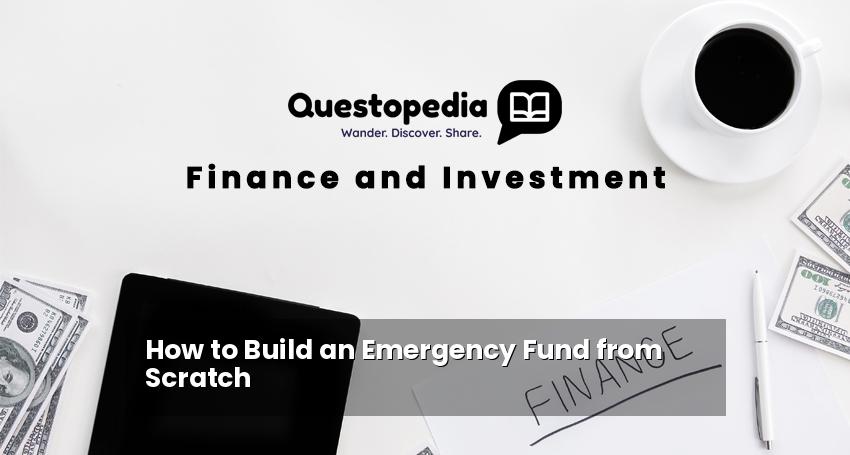How to Build an Emergency Fund from Scratch
Life is unpredictable. From unexpected medical bills to sudden car repairs, emergencies can throw your finances into disarray. That’s why building an emergency fund is crucial for financial security and peace of mind. But what if you’re starting from scratch? Don’t worry, this guide will walk you through the steps to create a robust emergency fund, no matter your current financial situation.
Why You Need an Emergency Fund
Before diving into the “how,” let’s understand the “why.” An emergency fund acts as a financial cushion, protecting you from going into debt when unforeseen expenses arise. Without one, you might resort to high-interest credit cards or loans, setting you back further. Having a readily available emergency fund can:
- Prevent debt accumulation.
- Reduce stress and anxiety related to unexpected expenses.
- Provide financial flexibility to handle job loss or income reduction.
- Allow you to avoid dipping into your long-term savings or investments.
Step 1: Assess Your Financial Situation
The first step is to understand your current financial landscape. This involves calculating your income, expenses, and debts. Use budgeting apps or spreadsheets to track where your money goes each month. Knowing your numbers is essential for creating a realistic savings plan. Consider using resources like NerdWallet’s budgeting guide to help you with this process.
Step 2: Set a Savings Goal
How much should you save in your emergency fund? A common recommendation is to aim for 3-6 months’ worth of living expenses. However, the ideal amount depends on your individual circumstances, such as job security, health, and dependents. A self-employed individual or someone in a volatile industry might need a larger fund than someone with a stable job. Start with a smaller, achievable goal, like $1,000, and gradually increase it over time.
Step 3: Create a Budget and Identify Areas to Cut Back
A budget is your roadmap to financial freedom. Examine your spending habits and identify areas where you can cut back. Small changes, like eating out less often or canceling unused subscriptions, can add up over time. Consider these strategies:
- Meal planning: Reduces grocery spending and eliminates impulse food purchases.
- Negotiate bills: Contact your service providers (internet, phone, insurance) and negotiate lower rates.
- Cut entertainment expenses: Explore free or low-cost entertainment options.
- Find free alternatives: Use library for books instead of buying.
Step 4: Automate Your Savings
Automation is your best friend when building an emergency fund. Set up automatic transfers from your checking account to your savings account each payday. Even small amounts, like $25 or $50 per week, can make a significant difference over time. Consider using online savings accounts with higher interest rates to maximize your earnings. Learn More About Financial Savings on our homepage.
Step 5: Find Extra Income Opportunities
Boosting your income can accelerate your emergency fund building process. Explore side hustles or part-time jobs that align with your skills and interests. Consider these options:
- Freelance work: Offer your skills (writing, design, programming) on online platforms.
- Drive for a ride-sharing service: Earn extra money by driving passengers.
- Deliver food: Deliver food through apps like DoorDash or Uber Eats.
- Sell unused items: Declutter your home and sell unwanted items online or at a consignment shop.
Step 6: Choose the Right Savings Account
Where you keep your emergency fund matters. Choose a high-yield savings account (HYSA) that offers a competitive interest rate while still being easily accessible. Avoid investing your emergency fund in volatile assets like stocks, as you’ll need the money to be readily available when an emergency strikes. Make sure the account is FDIC-insured for added security. Research different banks and compare their interest rates and fees.
Step 7: Resist the Temptation to Spend It
An emergency fund is specifically for unexpected and urgent expenses. Avoid using it for non-essential purchases, even if you’re tempted. Consider these to be considered as an Emergency:
- Job loss
- Medical bills
- Car repairs
- Home repairs
Treat your emergency fund like a safety net, only to be used when absolutely necessary.
Step 8: Regularly Review and Replenish
Life changes, and so do your financial needs. Regularly review your emergency fund to ensure it’s still adequate for your current circumstances. If you use money from your fund, prioritize replenishing it as soon as possible. Consider adjusting your budget or side hustle efforts to rebuild your savings.
Conclusion
Building an emergency fund from scratch takes time and effort, but it’s an investment in your financial well-being. By following these steps, you can create a safety net that protects you from unexpected financial shocks and provides peace of mind. Remember to start small, stay consistent, and celebrate your progress along the way. Having an emergency fund is a crucial step towards a more secure and stress-free financial future. You may also wish to consult a financial advisor for personalized advice. Start building your financial safety net today!






